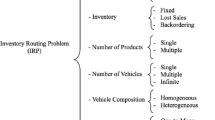Abstract
In this paper we consider a complex production-distribution system, where a facility produces (or orders from an external supplier) several items which are distributed to a set of retailers by a fleet of vehicles. We consider Vendor-Managed Inventory (VMI) policies, in which the facility knows the inventory levels of the retailers and takes care of their replenishment policies. The production (or ordering) policy, the retailers replenishment policies and the transportation policy have to be determined so as to minimize the total system cost. The cost includes the fixed and variable production costs at the facility, the inventory costs at the facility and at the retailers and the transportation costs, that is the fixed costs of the vehicles and the traveling costs. We study two different types of VMI policies: The order-up-to level policy, in which the order-up-to level quantity is shipped to each retailer whenever served (i.e. the quantity delivered to each retailer is such that the maximum level of the inventory at the retailer is reached) and the fill-fill-dump policy, in which the order-up-to level quantity is shipped to all but the last retailer on each delivery route, while the quantity delivered to the last retailer is the minimum between the order-up-to level quantity and the residual transportation capacity of the vehicle. We propose two different decompositions of the problem and optimal or heuristic procedures for the solution of the subproblems. We show that, for reasonable initial values of the variables, the order in which the subproblems are solved does not influence the final solution. We will first solve the distribution subproblem and then the production subproblem. The computational results show that the fill-fill-dump policy reduces the average cost with respect to the order-up-to level policy and that one of the decompositions is more effective. Moreover, we compare the VMI policies with the more traditional Retailer-Managed Inventory (RMI) policy and show that the VMI policies significantly reduce the average cost with respect to the RMI policy.
Similar content being viewed by others
References
Axsäter, S. (2001). “A Note on Stock Replenishment and Shipment Scheduling for Vendor-Managed Inventory Systems.” Management Science 47, 1306–1310.
Axsäter, S. and K. Rosling. (1994). “Multi-Level Production-Inventory Control: Material Requirements Planning or Reorder Point Policies?” European Journal of Operational Research 75, 405–412.
Berman, O. and R.C. Larson. (2001). “Deliveries in an Inventory/Routing Problem Using Stochastic Dynamic Programming.” Transportation Science 35, 192–213.
Bertazzi, L., G. Paletta, and M.G. Speranza. (2002). “Deterministic Order-up-to Level Policies in an Inventory Routing Problem.” Transportation Science 36, 119–132.
Blumenfeld, D.E., L.D. Burns, J.D. Diltz, and C.F. Daganzo. (1985). “Analyzing Trade-offs between Transportation, Inventory and Production Costs on Freight Networks.” Transportation Research 19B, 361–380.
Campbell, A.M., L. Clarke, A.J. Kleywegt, and M.W.P. Savelsbergh. (1998). “The Inventory Routing Problem.” In T.G. Crainic and G. Laporte (eds.), Fleet Management and Logistics, Boston: Kluwer Academic Publishers, pp. 95–113.
Campbell, A.M. and M.W.P. Savelsbergh. (2004). “A Decomposition Approach for the Inventory Routing Problem.” Transportation Science 38, 488–502.
Çetinkaya, S. and Lee, C.-Y. (2000). “Stock Replenishment and Shipment Scheduling for Vendor-Managed Inventory Systems.” Management Science 46, 217–232.
Chandra, P. and M.L. Fisher. (1994). “Coordination of Production and Distribution Planning.” European Journal of Operational Research 72, 503–517.
Cheung, K.L. and H.L. Lee. (2002). “The Inventory Benefit of Shipment Coordination and Stock Rebalancing in a Supply Chain.” Management Science 48, 300–306.
Cohen, M.A. and H.L. Lee. (1988). “Strategic Analysis of Integrated Production-Distribution Systems: Models and Methods.” Operations Research 35, 216–228.
Erengüç, Ş.S., N.C. Simpson, and A.J. Vakharia. (1999). “Integrated Production/Distribution Planning in Supply Chains: An Invited Review.” European Journal of Operational Research 115, 219–236.
Fry, M.J., R. Kapuscinski, and T.L. Olsen. (2001). “Coordinating Production and Delivery under a (z,Z)-Type Vendor-Managed Inventory Contract.” Manufacturing & Service Operations Management 3, 151–173.
Hall, N.G. and C.N. Potts. (2003). “Supply Chain Scheduling: Batching and Delivery.” Operations Research 51, 566–584.
Hu, T.C. (1982). Combinatorial Algorithms, Reading, MA: Addison Wesley.
Lee, H.L. and S. Nahmias. (1993). “Single-Product, Single-Location Models.” In Handbooks in Operations Research & Management Science, vol. 4, North-Holland: Elsevier Science Publishers, pp. 3–55.
Kleywegt, A.J., V.S. Nori, and M.W.P. Savelsbergh. (2002). “The Stochastic Inventory Routing Problem with Direct Deliveries.” Transportation Science 36, 94–118.
Kleywegt, A.J., V.S. Nori, and M.W.P. Savelsbergh. (2004). “Dynamic Programming Approximation for a Stochastic Inventory Routing Problem.” Transportation Science 38, 42–70.
Rabah, M.Y. and H.S. Mahmassani. (2002). “Impact of Electronic Commerce on Logistics Operations: A Focus on Vendor Managed Inventory (VMI) Strategies.” Technical Report N. SWUTC/02/167227-1, Center for Transportation Research, University of Texas at Austin.
Sarmiento, A.M. and R. Nagi. (1999). “A Review of Integrated Analysis of Production-Distribution Systems.” IIE Transactions 31, 1061–1074.
Thomas, D.J. and P.M. Griffin. (1996). “Coordinated Supply Chain Management.” European Journal of Operational Research 94, 1–15.
Toth, P. and D. Vigo. (2002). The Vehicle Routing Problem, SIAM Monographs on Discrete Mathematics and Applications, Philadelphia.
Wagner, H.M. and T.M. Whitin. (1958). “Dynamic Version of the Economic Lot Size Model.” Management Science 5, 89–96.
Webb, I.R. and R.C. Larson. (1995). “Period and Phase of Customer Replenishment: A New Approach to the Strategic Inventory/Routing Problem.” European Journal of Operational Research 85, 132–148.
Author information
Authors and Affiliations
Corresponding author
Rights and permissions
About this article
Cite this article
Bertazzi, L., Paletta, G. & Speranza, M.G. Minimizing the Total Cost in an Integrated Vendor—Managed Inventory System. J Heuristics 11, 393–419 (2005). https://doi.org/10.1007/s10732-005-0616-6
Received:
Accepted:
Issue Date:
DOI: https://doi.org/10.1007/s10732-005-0616-6




